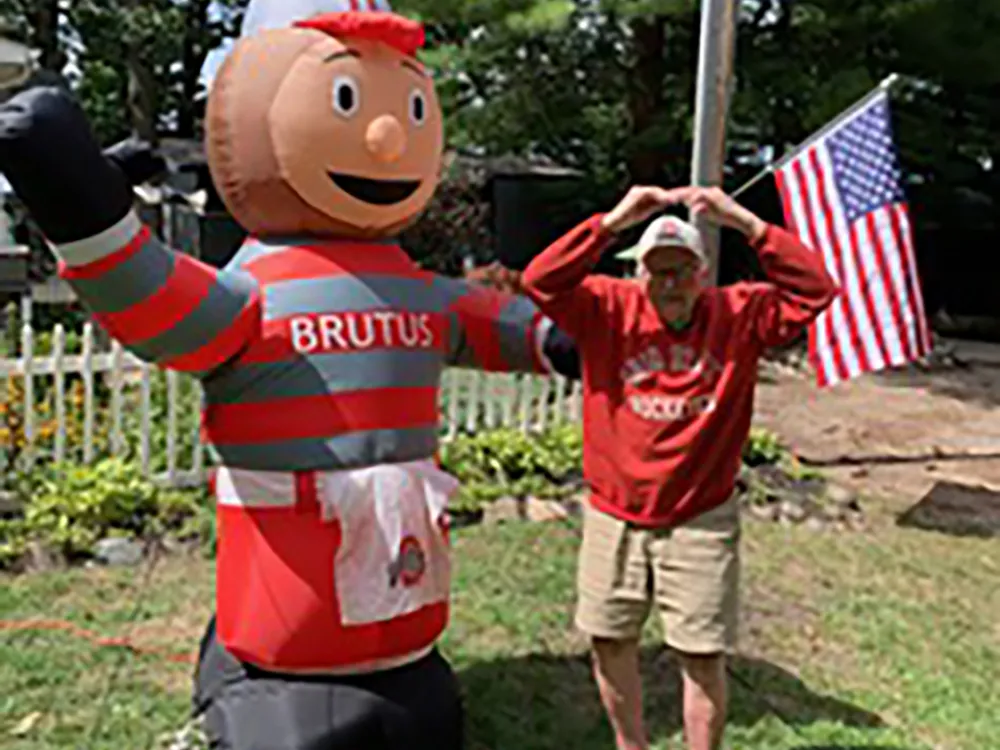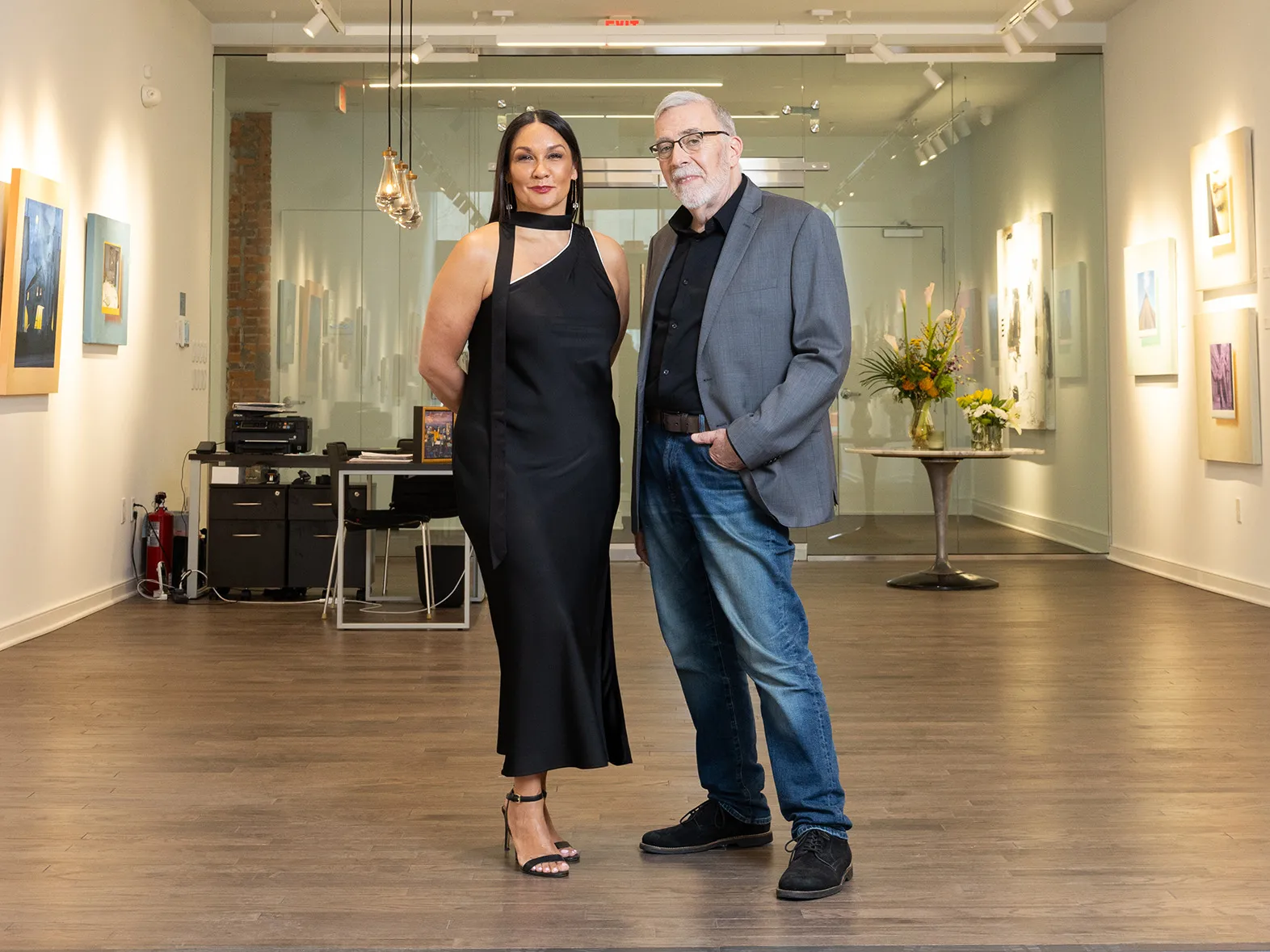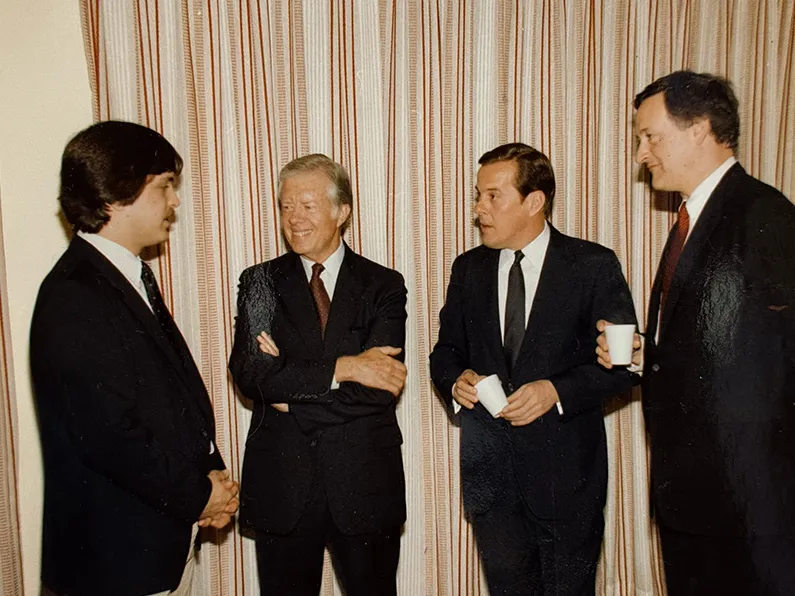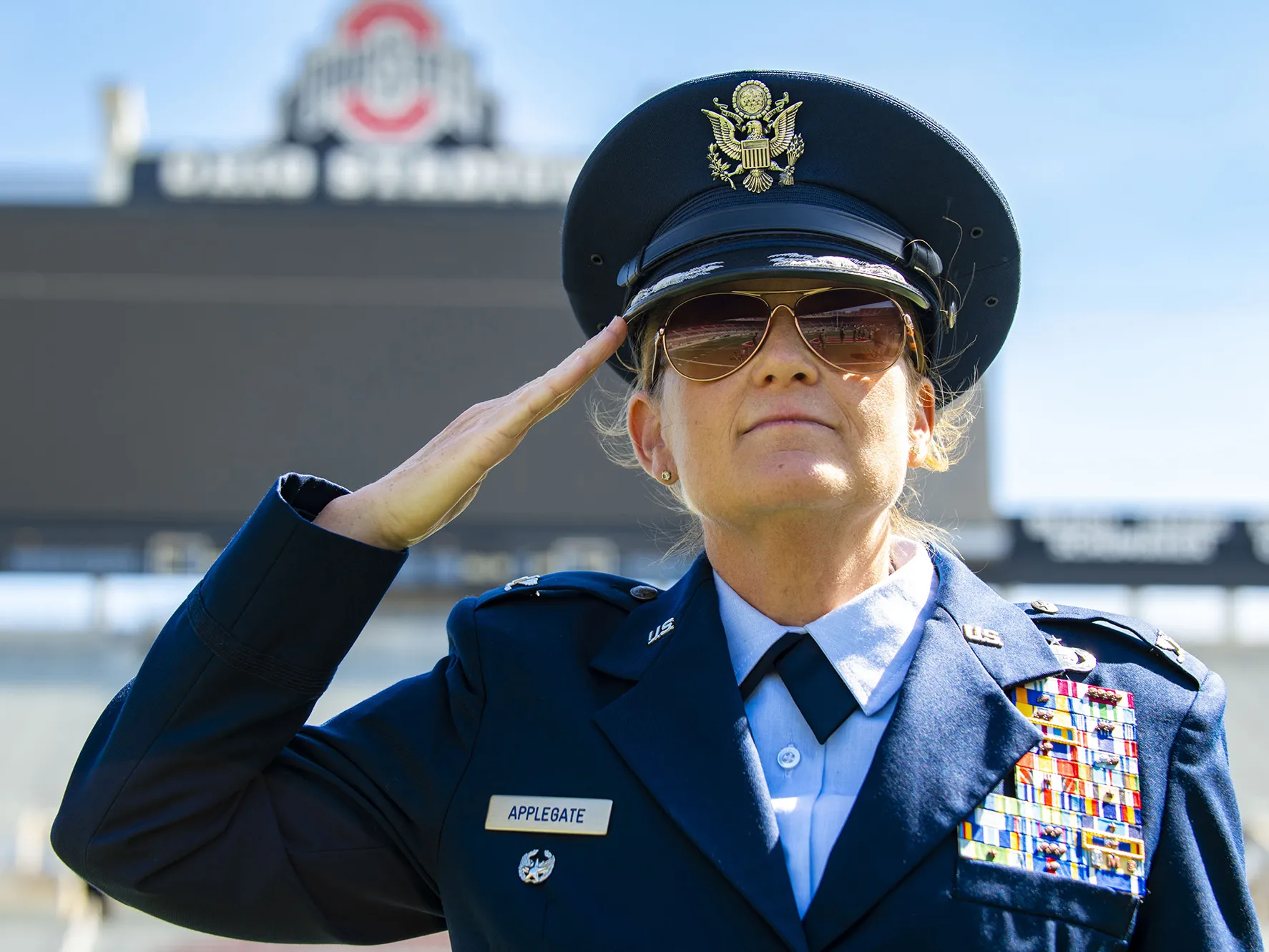Letters to the Editor
Ohio State Alumni Magazine welcomes readers to continue the conversations started in stories that appear online or in the magazine’s quarterly print edition. Letters selected for publication typically address topics raised in the magazine, although the editor sometimes makes exceptions. We edit submissions for space, clarity, accuracy and civility. Letters convey the opinions of the writers, not those of members of the magazine team, alumni association staff or university community.
Submit your letter at the bottom of this page.
-
Thanks from a Brutus fan
I am a few years younger than Brutus and an avid fan of the team, the university and the nut. When I graduated in ’91, Brutus was one of my favorite Buckeye traditions. When my son, Evan ’21, attended as a freshman, he sent me photos of his first Brutus experience. I have it on my computer today as he finishes his rotations in the College of Optometry. When he was little, we named his guinea pigs Brutus and Cletus Buckeye.
During my senior year, Brutus’ head was stolen, and it was all over The Lantern. It was returned safely, and Brutus continued. Scot Zellman ’90, The Lantern cartoonist, created Brutus’ evil twin, Cletus, and I loved his escapades in the comic strip. A friend in industrial design actually created a Cletus head and wore it one Halloween. A CletusFest tailgate continues to this day.
I never realized how much this tradition actually represents until I read this story. I didn’t know how much these stories would affect me, but I am deeply touched by them. Brutus is a true ambassador, and I count myself lucky to be a Buckeye.
Bill Goebel ’91Rittman, Ohio -
Hail Brutus!
To say I loved the feature on the Bruti (“Being Brutus Buckeye”) is an understatement. I laughed out loud and shed multiple tears as I read the wonderful comments by many who were Brutus. Thank you so much for letting us take a peek under the big
head. O-H!Ron Aaron Eisenberg ’67 MASan Antonio, Texas -
In praise of Jeremiah
I love watching Jeremiah Smith play, and it was wonderful to learn more about him as a person (“Jeremiah Smith, off the field”). My dad introduced me to chess as a youngster, too, as well as supporting me in my love of athletics and enjoyment of learning, all of which have helped me in later life. Great to get more insight about a well-known Buckeye athlete.
Richard Dawley ’71Hendersonville, North Carolina -
Jeremiah Smith, the student
A human-interest story like this helps us to remember that the student-athletes we support carry quite a load and appreciate our support. While essentially being in the entertainment business, they still have to go to classes and study.
Patrick Stephan ’73Uxbridge, Massachusetts -

A Buckeye turns 95
I am writing to tell you about my father, a proud Ohio State University alumnus:
Dr. James (Jim) R. Lowry
1952, B.S. in Business
1953, B.S. in Business Education
1954, M.B.A.
1966, PhD in Marketing
An interesting aside my dad has told us, while studying at Ohio State and serving as a graduate assistant, Jim was tasked with advising undergraduate business students. A young undergraduate met with him to discuss whether or not he should drop out to follow his dream of becoming a professional golfer. “Of course not,” Jim said. “Only a handful of folks make a good living out of playing golf. Focus on school.” Thankfully, Jack Nicklaus didn’t listen.
Jim recently enjoyed his 95th birthday with family and friends. He still walks 2-3 miles every other day and has no intention of slowing down. He is a very loyal Ohio State football fan, watching every minute of every game. The photo shows him at his home in Clear Lake, Indiana, cheering mightily alongside Brutus for another Bucs win!Chip LowryAlexandria, Virginia -
A century of Stone Lab
Having grown up in Sandusky, I appreciated this interesting history of the research lab (“Happy 100th, Stone Lab”). I’m so impressed to learn of the improvements it’s spurred in Lake Erie conditions! Also, educating students and the public about the lake is so important.
Kathie Killean ’76Cincinnati -
Another Houck-Barrett marriage
When I saw this article (“2 dorms, 26 marriages”), I realized that my husband and I were also a Houck-Barrett marriage, so add to that number! We met at a Houck-Barrett party in October 1977 and got married September 1979. Sadly, he passed away June 2010, but we started a scholarship in his name—the Thomas P. Nash Memorial Scholarship—in the College of Engineering.
Cheryl Worcester Nash ’79Pickerington, Ohio -
Regionals rule
I’m a proud, first-generation graduate of Ohio State Newark and the Columbus campuses. I loved reading this story of resilience and success (“Built for the future,” Fall 2025). First-gen college students have so many obstacles to overcome. My mom died right before my final quarter of college, and without caring professors and counselors, I might not have been able to finish my program. Ohio State regional campuses rock!
Sherri Lawrence ’95Zanesville, Ohio -

Praise from an art alumna
I enjoyed this article (“Art allies,” Summer 2025) very much and have known Michelle Brandt (above, with Duff Lindsay) since her early Ohio State experience in art education as a student teacher for me. Her energy, knowledge, perseverance and dedication to Columbus’ art scene are infectious! Thank you for this insight into two Ohio State grads who are making a difference!
Sandra Packer ’97Canal Winchester, Ohio -
Man of the mounds
This was a very interesting article about archaeologist Brad Lepper (“History, reclaimed,” Summer 2025). I have done some archaeology as a hobby over the years and have visited many of the mound sites in Ohio. I may have met Brad years ago. What a fine example of a scientist and human being. Great story!
Edith Wacksman ’68Scarborough, Maine -

Outstanding pharmacy leader
I had the privilege to learn from Emeritus Professor Milap Nahata during my time at Ohio State (“Proud he’s ours: He defined the best medicine for kids,” Summer 2025). During multiple years, the pharmacy classes voted him teacher of the year for his incredibly clear and informative lectures, and his kindness and compassion. He truly represents one of the most outstanding pharmacy leaders. We were so lucky to have him at Ohio State.
Debra Barnette ’90, ’93 PharmDOak Island, North Carolina -
Craft joins a stellar team
I am a patient at Ohio State’s hospital system. Had cancer of the throat 24 years ago. Got the best treatment ever so I’m sure ex-Ohio State basketball player Aaron Craft ’14, ’24 MD will do great things there like the doctors I had 24 years ago (“From basketball to surgery: Dr. Craft will see you now,” Spring 2025). The radiation doctor and my surgeon still see me one time a year. Saw Dr. Amit Agrawal this summer. Would not be alive without these great doctors.
Karen MooreEnglewood, Ohio -

Mapping campus changes
My wife, Amy Saunders ’79, ’83 MD, and I were at Ohio State from 1977 until 1987 with four degrees between us. We really enjoyed the map (“This map takes you to 1870 and back again and again,” Summer 2025). When we come back now, no surprise, the changes are huge. It was great to look back at our time there and then see the campus before we were there. Thanks.
David Rooney ’78, ’81 MSAnn Arbor, Michigan -
A tough (but worthy) test
Thanks for a great Summer issue. I loved The Big Buckeye Quiz. I didn’t score as high as I expected to but appreciated the “curve” questions. I learned more about Ohio State and individuals I met while a student. Great quiz. Hope to see more in the future.
Fred Rohs ’82 PhDAthens, Georgia -
Top-level talents
Thank you for publishing the important article on two outstanding architecture graduates from Ohio State (“Tale of two architects,” Spring 2025). I worked as marketing director for both Curt Moody (1997–2006) and George Acock (1990–1993).
Curt is maybe the best human being I have ever known—religious, kind and caring about each and every employee. Curt was a very competitive person; he was an Ohio State basketball player, and his goal was to grow his business into a major architectural firm. When I was hired, my mission was to help make that happen.
He had two very special skills: He was an excellent designer and architect, and he was a people person. When I was there, Curt had many employees who had worked with him for more than 20 years, which showed his team was happy working there. The firm won a major project designing a new recreation center at West Virginia University. The university contact said we listened and talked with them, while a New York firm came in to show why they were a great firm and even talked down to them.
George was the best design architect I ever met. To give an example, when he met a prospect or client, he brought with him paper to take notes and a sketch pad. When the meeting started, he opened his sketch pad and started to design. When the meeting was done, he gave the prospect or client the sketch. They were amazed—they knew then he had design ability.
His staffers were also with him forever; they knew him well and relied on him. Finally, he designed over 250 homes for Central Ohio VIPs. He was known at the top levels for his design talent.
Peter Kienle ’72, ’77 MBAPowell, Ohio -

When Jimmy Carter came to Ohio State
In 1984, I was a senior and had the privilege of working in the Office of the President, Edward H. Jennings ’90 DRH, a man who was my idol then and for the next 30-plus years. During that period, I was asked to coordinate the endowed Schooler-Reese Lecture Series on the Future of the American Presidency. I was a wet-behind-the-ears 22-year-old at a university whose stadium could seat five of every man, woman and child in my hometown.
The recent former president of the United States, Jimmy Carter, was one of the first lecturers. He could not have been humbler and kinder. He could tell I was afraid I would say the wrong thing. And why wouldn’t I be? I was just four years out from being a kid from a small farm town in eastern Ohio. In spite of my obvious nervous energy, he did his best to set me at ease.
I remember thinking that this was the man who led our nation, and he grasped my hand, looked me in the eye and asked how my day was going and where I was from. Did I enjoy my studies and what were my plans for the future? He was genuinely interested and seemed like he had absolutely nothing better to do than listen.
[About the photo: In 1984, from left are student Michael Cover, former U.S. President Jimmy Carter, Ohio State President Edward H. Jennings and Ohio Gov. Richard F. Celeste. Carter died in December, which prompted Cover to share this story.]
Michael Cover ’85Edgewater, Maryland -
Kudos for a life lived well
I enjoy reading about alumni who are enjoying full, impactful lives (“The vibrant world of Dr. Oglesbee,” Winter 2024). Additionally, my observation is that exotic pets are an important and growing segment of our pet world. It’s good to learn about someone who is meeting this need.
John Acomb ’65Beloit, Wisconsin -
Give Vance more coverage
As an Ohio State graduate and a reader of the alumni magazine for decades, I was extremely disappointed in the pitiful coverage/attention to the fact that an Ohio State alum, JD Vance, was elected to serve the United States as vice president (“Pioneers in politics,” Spring 2025 print edition). Please tell me that Ohio State Alumni Magazine will be having a full article about this most outstanding Ohio State graduate who has the most important job of any Ohio State alum at this time.
Judy Switzer Baird ’75Pataskala, Ohio -
Archie always a model Buckeye
The column by Molly Ranz Calhoun ’86 was excellent and thought-provoking. I am taking her up on her request for Archie stories.
In 1972, I had the privilege of attending The Ohio State University as a freshman. I was chosen to play in the marching band. My father was a professor at Ohio State. One night, he told me he had agreed that I would accompany one of his fellow professors to a weeknight church father–son banquet, since his colleague did not have any sons living locally. I knew the professor and liked him very much. But the last thing I needed was one more commitment when I was in the middle of midterm season.
The following week after band practice, I rushed to change clothes and go to North Broadway United Methodist Church, where I met the professor. We had a nice dinner and then one of the church members got up to introduce their invited speaker: none other than Woody Hayes.
Woody spoke graciously. But after a short time, he apologized and said he had to leave, because the university president requested he participate in another function that same evening. He said he had a very special speaker who was going to fill in for him. A fine young man who was a freshman, played on the football team, and was starting to gain a lot of attention for his athletic accomplishments.
Out walked Archie Griffin. Archie spoke with no notes. An 18-year-old college freshman who knew no one at this function. He started out with a little anxiety, but soon had all our attention. I forgot there were 200 other people there and felt as if Archie was speaking only with me. He talked about his youth in Columbus, football, Ohio State and people. I remember it like it was yesterday. I cannot imagine a comparable scenario taking place in today’s sports environment, but I am so grateful that it happened and that I got to know more of Archie Griffin than “just” the Heisman winner.
On occasion, I would run into Archie when walking between classes. I would wave and greet him. He always smiled back and greeted me. I’d like to think that he was doing something special for me. However, he did that for everyone. That’s just the kind of guy he is.
Kenneth Cahill ’75, ’79 MDColumbus -

TBDBITL helped her become colonel
When I joined The Best Damn Band in the Land during college, I had no idea it would lay the foundation for a long and successful career in the U.S. Air Force. Marching on the field in Ohio Stadium on game day is an incredible experience; it’s the work that goes into getting there that provided me the tools I’ve needed.
Everything we did in the band had meaning and not a day went by without the mention of a quote, such as “To be early is to be on time, to be on time is to be late, to be late is to be left” and “Pick up your feet, turn your corners square, and drive, drive, drive.” Life in TBDBITL truly taught me how to follow, how to lead, the importance of teamwork, what dedication and motivation mean, and how it feels to be a part of something way bigger than myself.
These are all traits I used while in Basic Military Training, on deployments, through Squadron Command, and now as a colonel in the USAF. I cannot think of a more meaningful place to have been promoted to colonel than on the football field at THE Ohio Stadium. Members of the alumni band performed during the ceremony, and that made it so much more meaningful. I’m so proud to be a Buckeye for life.
Col. Elisabeth Applegate ’97, ’05 MSWOsan Air Base, South Korea -
Stradley gang marks 50th
A bunch of guys who lived in Stradley Hall in the 1970s have been keeping a college tradition that we call The Annual alive for five decades, and we’re hoping others who were involved at the start will join us. After freshman year, as a way to keep in touch with friends on Stradley’s 10th floor, we held a cookout the summer of 1974. We did it again the next year and included other friends from Stradley and some girls from Canfield and Mack halls.
We kept the cookouts going throughout college, and weekend get-togethers replaced them after graduation. No matter where we moved, many of us returned for The Annual. Soon the group expanded to include spouses and kids.
Our gatherings evolved to tailgates and vacations for a while, but after a pandemic-induced hiatus in 2020, we brought The Annual back to Ohio. Each year, we rent a large cabin in Hocking Hills and enjoy cookouts, cornhole, golf and reminiscing.
It’s been challenging to stay in touch with some of the guys and girls from those early years. But we’re planning The Annual for this September at Hocking Hills, and we hope many friends will join us for the 50th anniversary of our first get-together. Interested folks can email me at josephpalbert@gmail.com.
Nothing could sum up our sentiments better than the words of “Carmen Ohio”: Time and change will surely show, how firm thy friendship — O-HI-O.
Joe Albert ’77Longwood, Florida -
Professor was a treasure
The fall issue’s In Memoriam essay that Tina Pierce ’01, ’01, ’04 MA, ’09 PhD wrote about Viola Newton ’85 MA, ’92 PhD was well done. It captures who Viola was as a professor and as a person. It is not every day that you meet someone who is as comfortable teaching a class in statistics as she is in literature. To her colleagues and friends, Viola was very opinionated and outspoken—but her words were truth. She cooked many meals for us, but went beyond extending material hospitality. Her very personhood was hospitable.
Valerie Lee ’76 PhDGahanna, Ohio
Join the Conversation Form
We welcome your letters. Those selected for publication typically address topics raised in Ohio State Alumni Magazine in print or online, although the editor reserves the right to make exceptions.
Please submit your letter below or email it to alumnimagazine@osu.edu. We ask that you limit your letter to no more than 250 words.